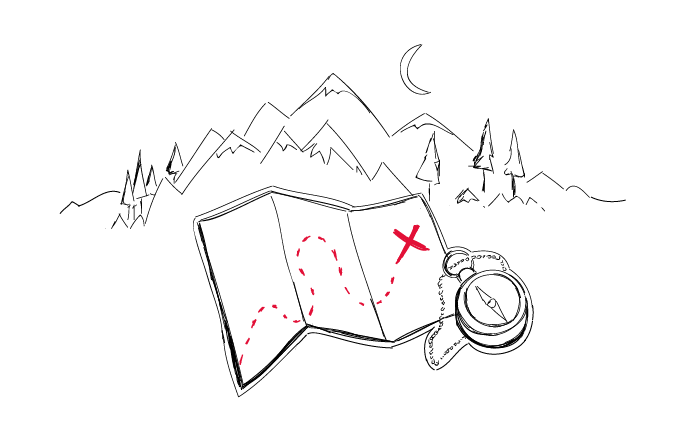Our users sometimes report to us that they couldn’t find enough time to run their outbound campaigns. Yes, a well-thought-out cold email campaign takes some time to get prepared. But what we often observe is that cold email senders want to go large from the very beginning: have a prospect base including thousands of addresses, an 8-touch email sequence with A/B testing, and so on. In this post, I’m going to show you why it’s more beneficial to start small. Check out what we call the lean approach to cold email, and why it’s worth testing.
I’ve organized this post as a Q&A. Hope it will help you find answers to some questions you may have been asking yourself for a while.
What do you mean by “lean approach”?
The idea behind lean approach is mainly that you can organize a process in such a way that will allow you to provide maximum value with minimum waste1. You may know the lean approach to building products from the book Lean Startup by Eric Ries (if you don’t, that’s something you really want to catch up with).
In a nutshell, the lean approach relies on “validated learning,” which is possible thanks to carrying out numerous experiments in dynamic cycles, and altering a product/service/process based on the results of those tests.
Ok, but what does it mean in the context of cold emailing?
Email outreach is a process. You can apply the lean approach to a process, so why not to try it with email outreach?
The idea is to prepare mini-samples of prospects, and small campaigns that you can quickly send and measure the effects.
So instead of collecting a huge base of prospects for months before sending, or buying one huge base for a significant amount of money, you can prepare a few smaller, high-quality contact bases.
And instead of creating a huge campaign with 7 follow-ups for thousands of prospects, you can prepare several smaller campaigns, and test how your value proposition resonates with different groups of prospects.
Plus, you can experiment with various versions of your email copy and check how well it works for those groups.
How many prospects do I need to start a campaign that makes sense?
If you aim at personalized email outreach, collecting a prospect base of 20-30 prospects from one group will take some time. But you don’t need more to run an experiment and observe the tendency of reply rates and positive reply rates to check, what works and what doesn’t. Note that I don’t talk about statistics here. I talk about a tendency you’ll be able to observe.
Some of our users upload thousands of prospects to Woodpecker, then add them to a single campaign, and try to send as many emails a day as possible to those prospects. Those senders believe that if they send a huge number of emails, they get a greater chance of getting a few positive replies.
That’s sometimes called the game of numbers. But this “go large” approach has a few significant drawbacks:
- To get a lot of prospects, you either need to spend a lot of time collecting your prospect base or you need to get the contacts from an outer source, i.e. buy them – which actually implies that you have no idea who your prospects are. Neither of the solutions is aimed at minimizing the costs and the possible waste.
- If you send the campaign to people you don’t really know, you can’t possibly personalize the emails, hence the quality of your outreach gets hurt. A generic email sent in bulk rarely brings any benefits to the sender.
- By sending one poor campaign to thousands of prospects you can really waste a lot of great contacts unless your campaign is optimized. If you run a test on a huge sample, and the test won’t bring any positive results, you’ve actually might have wasted thousands of potentially ideal prospects, just because you sent them a non-tested version of email copy. You’re risking a huge waste this way.
- If you create huge campaigns with hundreds and thousands of prospects, you need to wait long before the campaign gets completed. Sending thousands of emails, in a way that allows you to prevent getting blocked by your email provider, takes time. That eliminates the dynamic factor from your testing.
- Furthermore, what you’re instinctively trying to do, in such a case, is increasing the frequency of emails sent per day, which in turn may decrease your deliverability. And if your emails won’t even get delivered, you’re actually wasting your time in general.
All in all, you don’t need a thousand prospects to start your first campaign. You don’t even need a hundred. Aim at 20-30 prospect group samples to test your email copy and the choice of your target.
Prepare a first copy version, and send the campaign as soon as you have 20-30 prospects ready in your contact base. Observe the results. And get ready for testing.
How many prospects do I need to A/B test my campaign?
The next step is testing. It’s absolutely crucial in the lean approach. To get a clear answer to the question of what works and what doesn’t, you can A/B test your email campaigns.
Check the post on A/B Testing in Cold Email: How to Optimize Our Copy to Get More Replies? for more details on how to test your email part by part.
If you need 20-30 prospect for your first campaign, you need another 20-30 to run your first A/B test. If you’re testing email copy variations, ideally all the prospects should come from the same prospect group.
But if you want to test the efficiency of your campaign in various prospect groups, send the same copy version to two different types of prospects. That will allow you to test one thing at a time and draw clear conlusions.
Read the post on how to carry out A/B tests in Woodpecker >>
How many follow-ups should my campaign include?
The number of follow-ups is something you also need to test out.
But again, you can start from testing just 1-2 follow-ups in a sequence. You don’t need to start your testing from 7. It’s simply about time. Writing compelling email copy takes some time and thought. So it’s easier to prepare 1 follow-up for your first campaign and just give it a spin before you come up with the copy for more.
The idea is to take small steps in the process and test them as fast as possible. In the lean approach to building a product you’ve got an MVP (minimum viable product). The same can be applied here: the sooner you’ve got your first version of an email campaign, the sooner you can start testing, and the faster you’ll get the results.
And even if, ideally, you want to prepare 7 follow-ups, you won’t be able to send them all at once. In other words, you don’t need all the 7 of them to send the first one. So for starters, prepare just the first one, and send it to experiment. You can always add some more follow-ups to the same campaign later on.
How much time a day do I need to get my first cold email campaign running?
If you are going to go lean about that, you can divide the process of setting up your first campaign into a few steps that will require from you 1-2 hours a day to get things started.
First
Remember to prepare your mailbox for outreach a few weeks before you decide to start sending. This will allow you to warm it up, and thus make sure your emails will be delivered.
How to Properly Warm Up Your Email Address for Outbound >>
Second
While waiting for the mailbox, you can work on your prospect base. Pick a group of potentially ideal customers. Make some research. Think about personalization.
What’s the First Step to Building a Good Prospect Base? >>
Third
Once you know who you want to write to, start building your prospect list and at the same time think about your email copy. For starters, try to add 2-3 prospects to your list a day. If you can find more than that, that’s great! But it’s perfectly fine if, for starters, you regularly add 2-3 of them.
Check What Should Go First: Cold Email Copy or Prospect Base? to learn my process of planning the content of cold emails based on the available prospects’ info.
And the list of 25 Tools & Services for Outbound Prospect List Building may be helpful as well for finding the very contact details.
Be consequent
The most important thing there is to keep working on your campaign regularly. If you prepare your mailbox before and take 1-3 hours a day for two weeks, you’ll have a well-thought-out campaign ready to send sooner than you think.
Next, you can start your free trial at Woodpecker, and start sending your campaign automatically. This way, you’ll be able to keep working on the parts that require human touch (preparing new versions for A/B testing, collecting new prospects’ details, etc.), and have your emails sent for you in the meantime.
How do I know if my campaign works and if I should scale it?
Ok, so you’re going lean, testing things dynamically and improving regularly for some time. You see that some of your campaigns work better than others. But how do you actually know which of the test campaigns is worth scaling? And what does it mean to scale a cold email campaign?
First of all, you can measure as many factors as possible, but you should assess the effectiveness of your campaigns by the most important ones. If your campaign works, you’ll get positive replies and you’ll be able to start new business relations.
Whether you’re trying to set up calls, or you manage to stay in touch with your prospects via email, or you’re trying to arrange product demos, or you’re inviting people to start a free trial – you should measure the number of those started relations.
Pay attention to the right metrics
You can observe open rates, if you work on your subject lines. You can measure click-through rates, if you’re sending links to some materials. You should pay attention to general reply rates, and positive/negative replies ratio. You should control the bounce rate to always keep an eye on your deliverability. All these will help you improve your outreach.
But the real indication of success here will be the number of positive replies and the number of relations you’ve managed to start via email. So the campaign which generates the most positive replies will be the one to scale.
Basically, scaling will require from you adding more prospects from the same group to this campaign. But be careful with increasing the number of emails sent a day. Don’t get mad about quantity and speed.
What Are Email Sending Limits of Various Email Hosts? >>
Never give up on experimenting
And even if you create a campaign worth scaling, it doesn’t mean you should stop testing and improving. Cold emailing evolves. What worked 3 years ago, will not necessarily work today. What works today, will not necessarily work in 3 years. That’s why it’s crucial to keep improving, even if you’re at the point when you’re actually generating leads from outbound.
What’s in it for you?
Hope this will encourage you to try out the lean approach to cold email. Working out your way to effective email outreach takes some time and numerous tests. It’s important not to give up when your first campaigns don’t generate leads immediately.
Plan the process, start small and keep it regular. Test, test, and test some more until you find your own way to cold emails that work.
For more materials that may help you get around effective email outreach, check out the Comprehensive Guide to Cold Email >>
READ ALSO

Cold Email Statistics Based on Sending Over 20M Cold Emails
Over the span of 2 years, Woodpecker has grown a lot faster than we’ve predicted. We have 1000+ customers on board who come from 52 different countries. But what’s more important for today’s blog post, Woodpecker has sent way more than 20 million sales emails throughout all this time.

Our Customers Taught Us A Lot About Cold Emailing, Here Are 5 Top Tips
What is more valuable than first-hand advice from companies who grew with cold email outreach? I’ve put together a list of top 5 tips that can help you excel in running email campaigns. Let’s get straight to the point.

Step-by-Step Practical Guide to a Cold Email Campaign That Gets Delivered
Sending an automated cold email campaign is just a start. In the end, you want your emails to actually get to your prospects' inboxes. And to make that happen, it's crucial that you properly plan and set up your cold email campaign in every detail. I wrote this post in cooperation with our Support team and our Head of Integration & Deliverability, because we observed that many of our users still need help when it comes to properly adjusting their cold email campaign settings.

